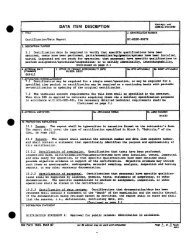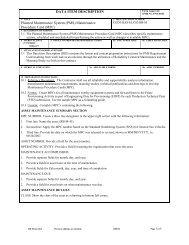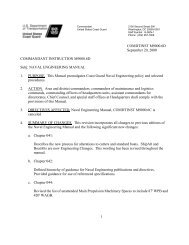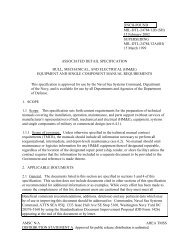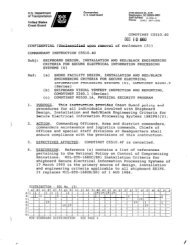comdtinst m2400.1f - US Coast Guard Response Boat-Medium
comdtinst m2400.1f - US Coast Guard Response Boat-Medium
comdtinst m2400.1f - US Coast Guard Response Boat-Medium
You also want an ePaper? Increase the reach of your titles
YUMPU automatically turns print PDFs into web optimized ePapers that Google loves.
. Urgency Calls. Transmit urgency and safety signals<br />
and urgency messages. (Safety messages should be<br />
transmitted on an authorized working frequency wherever<br />
possible after preliminary announcement on 156.8 MHz).<br />
2.B.5. c. Radio Station. Call radio stations other than <strong>Coast</strong><br />
<strong>Guard</strong> when other means of communication are not<br />
available or are not desired.<br />
d. Working Frequencies. Call <strong>Coast</strong> <strong>Guard</strong> units for the<br />
purpose of establishing communications and then shift to<br />
an appropriate working frequency for the passing of<br />
traffic. In districts where a guard is maintained on a<br />
working frequency, units should call and work on those<br />
channels.<br />
e. MSIB. Announce Maritime Safety Information<br />
Broadcast when required.<br />
6. 406.025 MHz. 406.025 MHz is used exclusively by satellite<br />
EPIRB's and ELT's for transmission of distress alerting,<br />
locating and identifying information to COSPAS-SARSAT<br />
satellites. Category I EPRIB's are automatically activated,<br />
float free devices. Category II EPIRB's are manually<br />
activated devices. Category III devices are similar to<br />
Category II, except they are designed to work in a warmer<br />
climate and for a shorter duration. All of these EPIRB's also<br />
transmit a low power 121.5 MHz signal for homing purposes.<br />
C. Emergency and Safety Frequencies.<br />
1. 8364 kHz: The frequency 8364 kHz, is designated for use by<br />
Survival Craft Stations and except as explained below its use<br />
shall be confined to this primary function. This frequency<br />
will not be used for this purpose upon full implementation of<br />
the GMDSS in 1999.<br />
a. 8364 kHz. <strong>Coast</strong> <strong>Guard</strong> units, other than aircraft,<br />
shall not transmit on 8364 kHz except in cases involving<br />
distress. A unit in distress may call a <strong>Coast</strong> <strong>Guard</strong><br />
station on 8364 kHz and request a reply on 8364 kHz.<br />
Since the unit in distress is in control of traffic on the<br />
frequency used for distress, the <strong>Coast</strong> <strong>Guard</strong> unit should<br />
comply with the request by answering on 8364 kHz if<br />
possible to do so. After replying to the call on 8364<br />
kHz, and if it is within the capability of the unit in<br />
distress to receive on another appropriate <strong>Coast</strong> <strong>Guard</strong><br />
working frequency, the <strong>Coast</strong> <strong>Guard</strong> station shall shift to<br />
this frequency as soon as practicable, care being taken<br />
that positive communications are not disrupted with the<br />
unit in distress.<br />
D. Search and Rescue Control Frequencies. Search and Rescue (SAR)<br />
control frequencies are for use between the Rescue Coordination<br />
Center ashore and the On-Scene-Commander. In addition to the<br />
frequencies listed in Annex J for this purpose, the appropriate<br />
<strong>Coast</strong> <strong>Guard</strong> common, District working, ship/shore and air/ground<br />
frequencies may be used for SAR control.<br />
2-4





